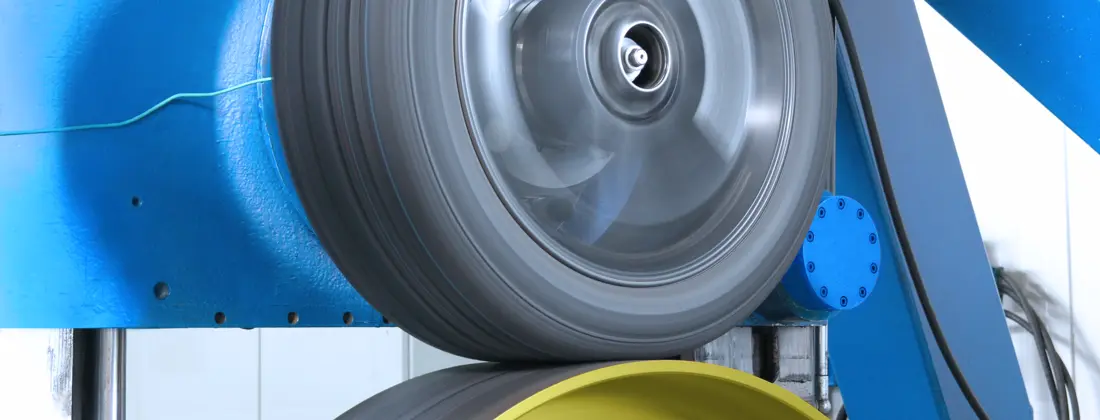EN 14252 Tyre Noise Cabin Testing
The European Standard EN 14252, "Tyres — Determination of sound pressure level in the passenger cabin," is a critical tool for manufacturers and suppliers to ensure their tyre products meet stringent noise regulations. This standard specifies methods for measuring sound pressure levels within the passenger cabin, which are influenced by the tyre's acoustic performance.
The testing process involves placing the tyre on a specially designed test wheel with an appropriate load and inflation pressure. The wheel is then rotated at specific speeds to simulate real-world driving conditions. A microphone placed inside the car captures the sound generated by the tyre as it rotates, providing a precise measurement of noise levels in decibels (dB).
The primary goal of this testing is to reduce noise pollution from tyres and improve passenger comfort. By adhering to EN 14252, manufacturers can ensure their products comply with European Union regulations, thereby avoiding potential legal issues and enhancing the overall driving experience.
In addition to ensuring compliance with international standards, tyre noise testing plays a vital role in the automotive sector by contributing to safer and more environmentally friendly vehicles. Lower noise levels from tyres not only enhance cabin comfort but also contribute positively to air quality by reducing road traffic noise pollution.
The testing apparatus typically includes a sound level meter and a rotating test wheel that can be adjusted for different tyre sizes and load conditions. The process involves several steps, including setting up the test environment, mounting the tyre on the appropriate wheel, rotating the wheel at specified speeds, and recording the sound pressure levels inside the cabin.
The results of EN 14252 testing are crucial for product development in the automotive industry. By identifying noise sources early in the design process, manufacturers can make necessary adjustments to improve tyre acoustics. This not only enhances consumer satisfaction but also supports broader sustainability goals by reducing environmental impact.
In summary, EN 14252 is an essential tool for ensuring that tyres meet strict noise regulations and contribute positively to the driving experience. It provides a standardized method for measuring cabin sound pressure levels, which helps manufacturers improve their products and comply with international standards.
- Sound Pressure Levels: Measured in decibels (dB), these indicate the volume of noise generated by tyres.
- Test Environment: Controlled conditions that simulate real-world driving scenarios.
- Rotating Wheel: Used to simulate tyre rotation and generate sound data.
- Microphone Placement: Inside the car cabin, capturing noise generated by the tyre.
Why It Matters
The importance of EN 14252 cannot be overstated. Noise from tyres is a significant contributor to overall traffic noise pollution, which can have adverse effects on public health and the environment. By adhering to this standard, manufacturers can significantly reduce cabin noise levels, leading to quieter rides and improved passenger comfort.
In addition to enhancing driving experiences, meeting EN 14252 standards is crucial for regulatory compliance. Many countries around the world are implementing stricter regulations on tyre noise to protect public health. Non-compliance with these regulations could result in legal penalties and damage to a company's reputation.
The standard also supports broader sustainability goals by reducing environmental impact. Lower noise levels from tyres contribute positively to air quality, making it an essential step towards achieving global environmental objectives.
Finally, adhering to EN 14252 can lead to competitive advantages in the market. Consumers are increasingly prioritizing eco-friendly and quiet tyre options, and meeting this standard demonstrates a company's commitment to these values. This can enhance brand reputation and drive sales.
Why Choose This Test
- Compliance: Ensures strict adherence to European Union regulations on tyre noise.
- Innovation: Provides insights into improving tyre acoustics for enhanced driving experiences.
- Sustainability: Supports global efforts towards reducing environmental impact by minimizing noise pollution.
- Market Advantages: Enhances brand reputation and drives sales by offering quieter, more comfortable tyre options to consumers.
The EN 14252 test is a critical step in the development and quality assurance process of tyres. By incorporating this testing into their procedures, manufacturers can ensure that their products not only meet regulatory requirements but also provide superior performance and comfort.
International Acceptance and Recognition
EN 14252 is widely recognized and accepted in Europe and many other parts of the world. Its acceptance by major automotive manufacturers and regulatory bodies underscores its importance in ensuring tyre noise compliance.
The standard is aligned with international regulations, including those set forth by the European Union and various national standards organizations. This alignment ensures that manufacturers can meet global requirements without extensive modifications to their testing protocols.
Many leading tyre manufacturers have embraced EN 14252, recognizing its value in improving product quality and meeting regulatory demands. By adopting this standard, companies can ensure they are at the forefront of industry best practices, setting a benchmark for others to follow.
In conclusion, the international acceptance and recognition of EN 14252 highlight its significance in the automotive testing sector. Its widespread adoption ensures that manufacturers can meet global standards while enhancing product performance and driving innovation.





